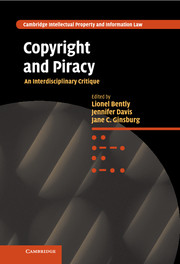Book contents
- Frontmatter
- Contents
- Notes on the contributors
- Editors' preface
- Table of cases
- Table of statutes
- Part I Introduction
- Part II History
- Part III Comparative Law
- Part IV Economics
- Part V Linguistics
- Part VI Computer software
- Part VII Information studies
- Part VIII Literature
- Part IX Art
- 16 Piracy and authorship in contemporary art and the artistic commonwealth
- 17 Copyright's imperfect republic and the artistic commonwealth
- Part X Sociology/music
- Part XI Criminology
- Bibliography
- Index
16 - Piracy and authorship in contemporary art and the artistic commonwealth
from Part IX - Art
Published online by Cambridge University Press: 17 November 2010
- Frontmatter
- Contents
- Notes on the contributors
- Editors' preface
- Table of cases
- Table of statutes
- Part I Introduction
- Part II History
- Part III Comparative Law
- Part IV Economics
- Part V Linguistics
- Part VI Computer software
- Part VII Information studies
- Part VIII Literature
- Part IX Art
- 16 Piracy and authorship in contemporary art and the artistic commonwealth
- 17 Copyright's imperfect republic and the artistic commonwealth
- Part X Sociology/music
- Part XI Criminology
- Bibliography
- Index
Summary
Introduction
This chapter is about the tension between concepts of authorship and piracy in contemporary art and in copyright law. On the one hand, it questions how far copyright (which regulates the reproduction of cultural media) applies to the contemporary art system (which is based upon the production and distribution of unique, ‘original’ artefacts) either as an incentive for artists to create artworks or as a source of authorial protection.
It suggests that the ‘high’ art system, which emphasises the authenticity and provenance of unique artefacts, has generated an alternative system of authorship and enforcement for artists to that found within copyright law where infringement actions best suit authors whose work is linked to reproductive cultural media, such as music, literature and film. Discussing movements such as Pop art, Minimalism, Conceptual art, Appropriation art and their descendants, it considers key aspects of artistic authorship, including the authority of artists to designate an apparently limitless array of objects as artworks (including copies) and to delegate control to others in the artwork's creation and execution. It argues that the institution of authorship within contemporary art (and in particular, the desire of artists to control their work after sale) has created its own system of ‘administrating aesthetics’ in which authorisation by the artist and his or her estate of the work is fundamental, rather than enforcement of exclusive rights to copy.
- Type
- Chapter
- Information
- Copyright and PiracyAn Interdisciplinary Critique, pp. 311 - 339Publisher: Cambridge University PressPrint publication year: 2010



